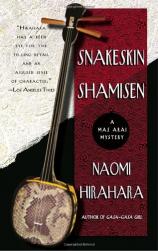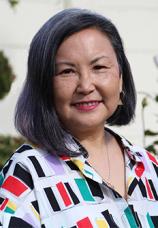Interview: April 28, 2006
April 28, 2006
Bookreporter.com's Senior Writer Joe Hartlaub interviewed Naomi Hirahara, author of several nonfiction titles about the Japanese American experience and a fictional mystery series starring Mas Arai. Hirahara discusses the inspiration for the series's latest installment, SNAKESKIN SHAMISEN, as well as its main character's possible real-life counterparts. She also compares and contrasts writing fiction and nonfiction, and reveals what she has in store for her protagonist.
Bookreporter.com: SNAKESKIN SHAMISEN is your third novel to feature Mas Arai, who is a unique protagonist in contemporary mystery fiction. He is a 70-something gardener who would like nothing more than to be left alone, yet he is often drawn --- albeit reluctantly --- into the problems and mysteries of others. Is there a real-world inspiration for Arai?
Naomi Hirahara: Mas is inspired by my father, who also happens to be a gardener and an atomic-bomb survivor. But the similarities end there. Personality-wise, I think Mas represents many of us who are pretty focused on the details and passions of our own private lives, but are occasionally shaken up by those seminal events that force us to make choices and form opinions on a larger, societal scale. Injustice is perpetuated not only by evildoers, but also by regular folks who just watch it happen.
BRC: One of my favorite elements of your novels, particularly in SNAKESKIN SHAMISEN, is that you introduce your readers to Japanese-American culture in a way that makes what is novel to (most) hakujin to be almost immediately familiar. Do you write first and then go back and polish these sections to flesh them out, or is that part of your natural writing process?
NH: It's part of my natural writing and thinking process. As a daughter of an immigrant, I learned to negotiate two cultural worlds at a young age. You serve as an interpreter of the outside world for your parents. In my books, I do the reverse: I interpret a closed world for the outside world. Since I've sat in both positions, it's quite easy for me to have multiple cultural points of view. At the core of my writing are human experience and human nature --- and that's universal.
BRC: The shamisen, a stringed instrument used extensively in traditional Japanese music, also figures prominently in SNAKESKIN SHAMISEN in a number of ways. It seemed as if there was a subtle reverence for the instrument that flowed throughout the novel. Do you have a particular emotional attachment to the shamisen that inspired you to write a novel around it?
NH: The shamisen, also referred to as a samisen or sanshin by Okinawans, is a vital cultural icon in Okinawan American culture. My husband's roots are in Okinawa (three generations removed) and when we were cleaning his grandmother's house after her death, we found a beat-up old snakeskin shamisen. I believe that image stayed in my mind. It's been fun as I show the SNAKESKIN SHAMISEN cover to different people who also have distant connections to Okinawa. They all seem to have that same story of a dusty shamisen stored in a corner closet.
Although I didn't grow up listening to Okinawan sanshin music, I borrowed many CDs from the library and played them while I was writing the book.
BRC: One of my favorite aspects of Arai's character is his "fish-out-of-water" persona. He is not fully assimilated into American culture, yet Japanese-American culture is evolving beyond him as well. He is able to move between, and within, elements of both successfully, an ability that enables him to gather information unexpectedly easily. What sort of evolution did Arai experience between your first conception of him and his appearance in your first novel, SUMMER OF THE BIG BACHI?
NH: Mas didn't start up to be a reluctant sleuth. In earlier incarnations, SUMMER OF THE BIG BACHI was more of a literary book, not a mystery. Mas was much more passive and stuck in his own world. The first version of the book was written from two points of view --- Mas's and the voice of a young doctor from Hiroshima. As a result, most of the tension arose from Mas not understanding the new generation from Japan. As I refined and rewrote the book, Mas became an active guide into the Japanese American community.
BRC: I understand that your next book will be a stand-alone work, and that you will then return to Mas Arai's world. What do you foresee happening with Arai in the future? Do you ever plan to perhaps return Arai to Japan?
NH: Mas will continue to get involved in mysteries through his circles of friends. I plan to investigate the redress movement, in which Japanese Americans held in World War II camps received an apology and monetary reparations from the U.S. government in the 1990s. That movement was an incredible demonstration of democracy at work. As Mas is starting to befriend an African-American professor, this next mystery will resonate beyond the Japanese American experience. I've also been learning a lot about judo dojos in Los Angeles from a local historian who has written a nonfiction manuscript. It's fascinating because a number of hakujin society women in the 1930s were involved in learning judo from Japanese Americans. Threads of a potential mystery are coming together. And finally, yes, Mas will eventually return to Hiroshima. I envision that as being the last book in the series. That will involve a lot of research and travel, I imagine!
BRC: What caused you to choose the mystery genre when you began writing fiction? Do you favor mysteries when reading for pleasure? What authors, if any, have influenced your fictional work?
NH: The mystery genre chose me! I found it to be the perfect container for Mas's stories. I've loved the classics by Northern European women writers --- Dorothy L. Sayers and Josephine Tey, to name a few. In terms of influences, they would have to be Chester Himes, Walter Mosley and Arthur Miller.
BRC: While many readers know you primarily as a mystery novelist, you in fact have edited and written a number of critically acclaimed nonfiction works, including two biographies. What are the advantages and disadvantages to writing fiction as opposed to writing nonfiction. Does your work schedule differ between one or the other? If so, how?
NH: I spend much more time doing research on my nonfiction books. And I need to be very systematic on how I record sources. If I do an oral history interview, I need to back it up with written documents or other accounts. Probably 40 to 50% of my time is devoted to research and interviews for my nonfiction books.
For fiction, I need to live in my head more. I may spend only a month or two doing research and gathering information for my mysteries. Many times I've woven information from my nonfiction work into my fiction --- so dual uses!
Writing fiction can be a very isolating and disconnecting process. But it's also very exciting. It's very easy for me to write a detailed outline for my nonfiction after I've completed my research. The collection of data determines the arc of my story, etc. Nonfiction really requires you to be a detective, to be very observant and cognizant of what your five senses will dig up.
Fiction is a much more magical, spontaneous and risky creative experience, at least for me. You must rely on your sixth sense of memory and imagination. You are mining layers of your own experience, from childhood to now, while also depending on your outside observations. You really have no idea whether that literary note that resides at the center of your work will connect with anyone else --- that is, until you've released it in the form of a book. We writers are so extremely fortunate to have this opportunity.




